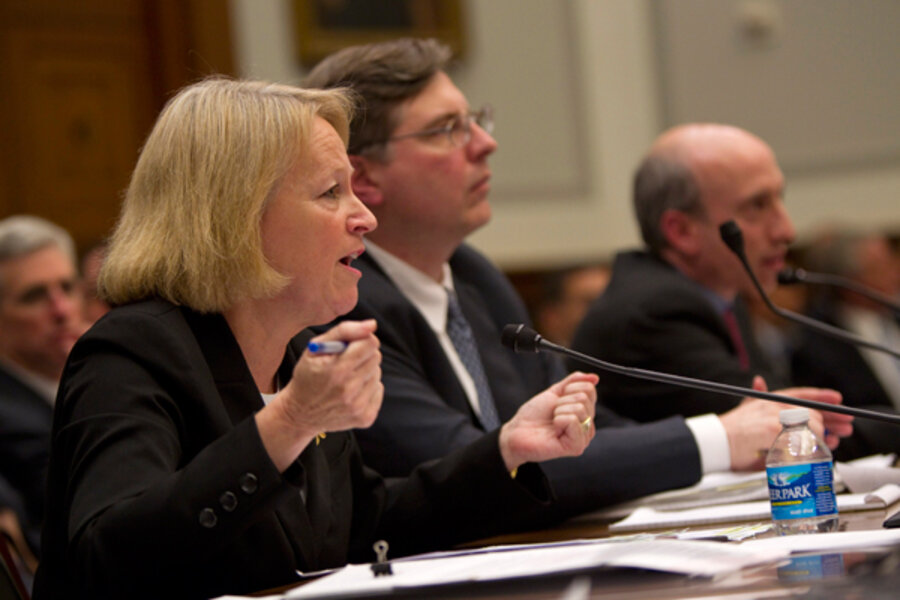Days later, mystery still shrouds stock market's 'flash crash'
Loading...
Five days after the US stock market went haywire, securities regulators said Tuesday they have no solid answers about what went wrong.
But regulators and stock market executives, appearing before a congressional panel, said they'll pursue new "circuit breakers" designed to reduce the risk of a repeat in the kind of unusual volatility that left investors amazed and exasperated last Thursday.
The event at issue has been called by some the "flash crash."
US Stock prices had fallen more than 2 percent by early afternoon Thursday, but then the plunge suddenly and inexplicably accelerated. The Dow Jones Industrial Average was soon down more than 8 percent. Then, just as suddenly, share prices surged upward and the market closed with a roughly 3 percent loss for the day.
"I think we would all agree that the market did not [work]," said Lawrence Leibowitz, chief operating officer of NYSE Euronext, which operates the New York Stock Exchange.
In fact, the erratic trading on May 6 is exposing two sides of Wall Street that both are disturbing to some investors. First, exchanges have become so complex that even insiders can't easily explain the kind of mayhem that occurred Thursday. (Even blue chip stocks including Procter and Gamble plunged as much as 30 percent in a few minutes.)
Second, for all the mysteries, Wall Street has a public-relations challenge, as the investigation amplifies concerns about whether computerized trading by sophisticated firms is helping or harming America's capital markets.
"To what extent do you agree with the view that these high-frequency traders are just parasites on the market?" Rep. Brad Sherman (D) of California asked Mary Schapiro, chairman of the Securities and Exchange Commission.
So far, the practice of high-frequency trading, in which firms seek to take advantage of profit opportunities that last for fractions of a second, has not been implicated as a cause of Thursdays mini-crash.
But Ms. Schapiro said the SEC is working to assess the role of these trades, and how they affect the markets.
She said the inquiry into May 6 so far has not found evidence that the cause involved computer hackers, cyber terrorists, of a big investor making an erroneous trade due to a "fat finger" on the keyboard. She also downplayed the view that trading in so-called E-mini contracts (a trade in stock-index futures) played a key role.
Commodity-market regulator Gary Gensler, although he also did not label E-mini as the leading cause, reported that one trader in those contracts was selling short (betting on a decline) and accounted for about 9 percent of E-mini trades between 2:32 and 2:51 p.m. on Thursday.
"The trader sold on the way down and continued to do so even as the price level recovered," said Mr.Gensler of the Commodity Futures Trading Commission, in his prepared testimony. "This trader and others have executed hedging strategies of similar size previously."
US stock markets already have so-called circuit breakers, designed to create a time-out during periods of unusual volatility. But the May 6 experience suggests that additional breakers are needed, with a focus on individual stocks rather than the broad market, the regulators said.
Thursday saw 66 million trades, Schapiro said – far more than was typical in 1987 when the stock market had a severe one-day crash.
Gensler added that the role of computer technology is exponentially greater on Wall Street than it was then. For all the talk of so-called program trading back then, it was "nothing like what we have now," he said.
"We will get to the bottom of this," Schapiro said regarding the May 6 events, but "that's going to take time."
While emphasizing the mystery that remains unsolved, both regulators and exchange executives told lawmakers that Thursday's trading was influenced by turbulent news from Europe, as investors looked at images of protests in Athens related to the Greek debt crisis.
Schapiro also said the SEC will look into how exchanges cope with the aftermath of a day like Thursday. Some trades are "busted" (canceled) after the fact when the exchange finds highly abnormal market behavior. But Schapiro acknowledged that the process is not transparent and is "highly unsatisfying" for investors.
Related:





